Zinnias are annual plants which go through their entire life cycle within a year. It’s interesting to watch the zinnia plant as it goes through different stages of growth. Starting with the germination of a tiny arrow shaped seed, and evolving into a plant with multi-petalled and colorful blooms, the zinnia growth stages are impressive.

If you’ve never grown zinnias, consider growing this wonderful flowering plant in your flower garden this season. The bright colors are eye catching, and are available in a variety of different colors.
These plants are some of the easiest flowers to grow from seed. They also offer a colorful palette to many flower gardens, as well as to any floral arrangements in which they are used.

Understanding The Zinnia Life Cycle
If you are growing zinnias for the cut flower garden, knowing the zinnia growth stages is important. This knowledge will help to guide you in understanding the plant’s growth time, as well as being aware of the right stage to harvest.
It will also make you aware of different techniques to use at the different stages of growth.
One of my favorite stages, besides the beautiful flowering stage, is the seed production stage. This stage comes along with the bountiful harvest of zinnia seeds at the end of the growing season.
If you know the zinnia growth process, you will be able to harvest those seeds, to plant out next year. As a result you can have these beautiful flowers growing in your flower garden year after year.
When I first started growing zinnias, it was amazing to see the plants grow and change, within just a matter of months.
From those uniquely shaped seeds growing into sometimes massive plump flowers, the growth in such a short period of time is spectacular.

Introduction To Zinnias
Zinnia plants are members of the Asteraceae Family, the Genus Zinnia, and the Tribe Heliantheae. The species name for the common zinnia is Zinnia elegans.
Zinnias are heat loving annual flowering plants, which produce colorful dome shaped flowers with interesting color variations.
Annual plants are those plants which complete their life cycle within a 12 month period.
So essentially, zinnias will grow and bloom in the season they are planted. These plants will begin and then complete their entire life cycle within the same growing season.
Zinnias love the heat and a sunny location, as well as the hot summer temperatures for their best growth.
There are many different cultivars of zinnia plants, all which are unique in the own way.
If you happen to save some zinnia seeds for planting, the resulting plants will also be hybrids and unique plants as well.

Zinnia Flowers
Zinnias are available in many different varieties, which offer lots of different colors, as well as bloom types.
The flowers are composite. This means that the blooms are made up of an outer edge of ray florets, as well as a central disc containing disc florets.
The flowers can be singles, with an outer rim of ray petals and an interesting central disc. The flowers can also be semidouble or double blooms, with dome shape flowers consisting of layers of the colorful ray florets.
The vibrant colors of zinnia blooms range from white, cream, chartreuse, pink, salmon, red, orange, yellow and purple. They are often multi colored, and multi toned within a single bloom.
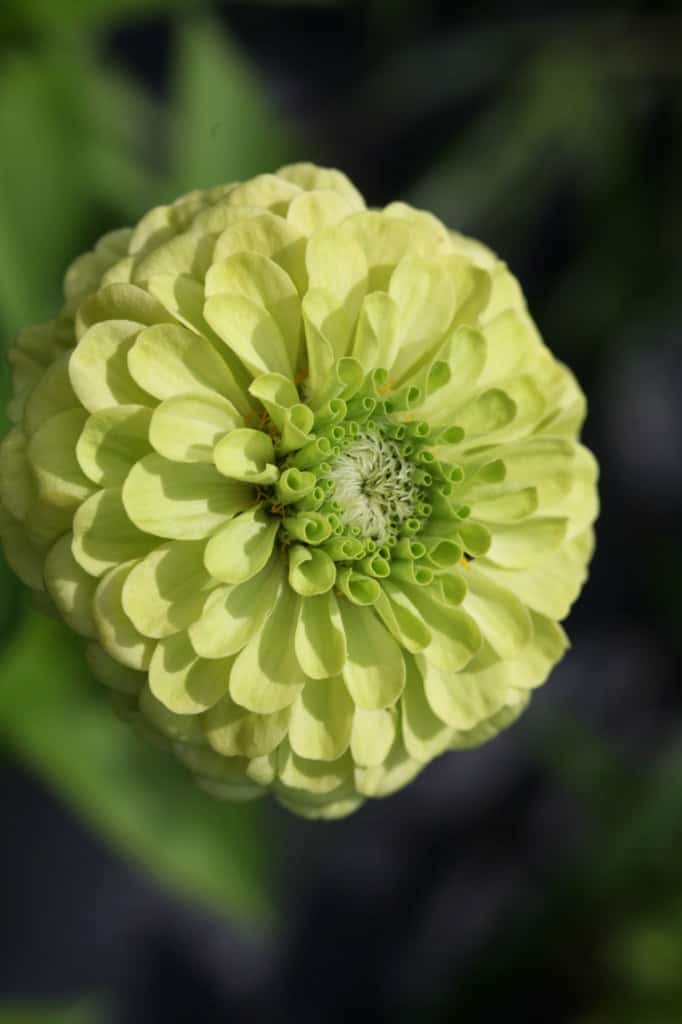
The zinnia varieties also come in a mix of different heights and sizes. The plants range from tall varieties such as the Benary’s Giant to more compact and dwarf varieties such as the Thumbelina mix zinnias.
These gorgeous flowers are prolific producers. They will bloom all summer long once the flowers start to bloom, and are a great choice for the flower beds.

What Is The Life Cycle Of A Zinnia?
In the life cycle of a zinnia, the plant will typically go through different growth stages.
Zinnia growth stages include:
- Germination Stage
- Seedling Stage
- Vegetative Stage
- Pre- Flowering Stage
- Flowering Stage
- Post Flowering Stage
- Seed Production
So let’s have a closer look at the individual growth stages of the zinnia plant in more detail.
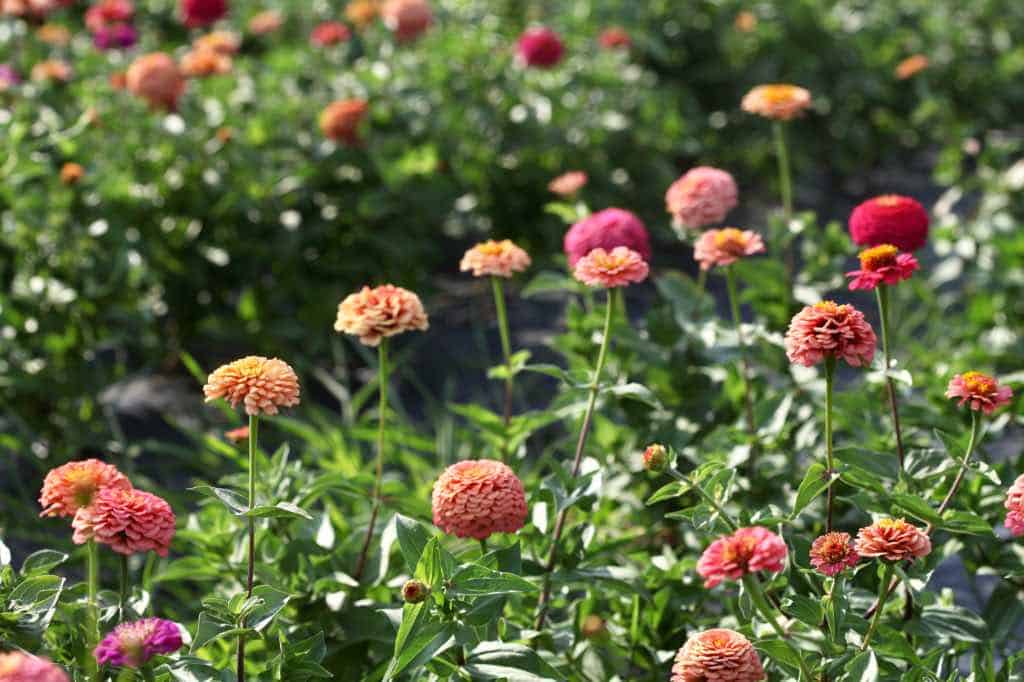
Zinnia Growth Stages
1. Germination Stage
The first stage of growth is the germination stage, involving the stimulation of the zinnia seed to begin to grow.
The seeds are planted into soil, and watered, which will stimulate the germination process.
Zinnia seeds do not require any special preparation prior to planting, such as stratification.
In fact in colder growing zones, the cold winter temperatures and freezes will generally eliminate the ability of any self seeded zinnia seeds to germinate. Zinnia seeds often become destroyed in these freezing climates over winter, if left outside.
Zinnia seeds can be planted either indoors in seed starting containers, or directly sown into the garden after the danger of frost has passed.
The plants do not particularly like to be transplanted from one location to another, and prefer to be direct sown.
However if you live in a colder climate where planting dates are much later, it’s usually best to start the zinnia plants a little earlier inside, to get a head start on the growing season.
They will still transplant, although sometimes show signs of stress when first planted out.

If Growing Indoors
- Plant the seeds into a container such as a seedling cell tray or peat pots filled with a sterile soilless seed starting medium. Seeds can be covered with a thin layer of soil or vermiculite.
- Bottom water the tray, and keep the soil moist while the seeds are germinating.
- Moist soil is important during the germination stage. Do not allow the planting medium to go dry during this stage, as this can lead to seed loss.
- You will have best success with germination of the seeds if you place the tray on a heat mat. The heat mat will provide bottom heat, which will warm up the planting medium.
- Once 60% of the seedlings have germinated, transfer the tray from the heat mat to a shelf with grow lights.
- The seedlings will remain under the lights until they can be safely transplanted out in spring, after they have been hardened off. Plant out after the risk of frost has passed.

If Growing Outdoors
- Zinnias are heat loving plants which do not tolerate the cold, especially the frosts of early spring.
- It’s important therefore to wait until the last frost date has passed in your usda plant hardiness zone, before planting your zinnia seeds into an outdoor space in late spring.
- If direct sowing into the garden choose a sunny spot, and plant onto a prepared weed free bed full of rich fertile soil.
- Space the seeds about 6 inches apart.
- Cover the seeds with a fine layer of soil approximately 1/4 inch deep, and water in. Keep the soil moist until the seeds have germinated.

How Long Does It Take Zinnias To Germinate?
Zinnia seeds will generally germinate in approximately one to three weeks, depending on the cultivar, as well as the growing conditions.
A warmer soil temperature will help to enhance the germination process for zinnia seeds.
2. Seedling Stage
When the zinnia seeds have germinated, and the tiny plants begin to grow, the plants enter the next stage. This next stage is the seedling stage.
It’s so exciting to see all of the new seedlings, as they begin to grow. These tiny plants are just the beginning of all of that beauty that will present itself in the garden, within just a few months time.
As the seedlings begin to grow, they will develop their first set of true leaves. They also are beginning to establish their root systems at this time.

At What Point Do Zinnias Start Producing Leaves?
The zinnia seedlings start producing leaves within weeks of germinating. They will continue to grow and produce new leaves on this first stem over time.
As the plants begin to mature they will begin to produce more stems from the base of the plant, as they enter the next stage of growth.
If you have started the seeds indoors, and are growing them under lights, continue to care for the seedlings in this location, until the last spring frost date has passed in your growing zone.
At this point the seedlings can be hardened off, and then planted into the garden, where the growth of the plants will really take off.

3. Vegetative Stage
The next stage of zinnia growth is the vegetative stage.
The vegetative growth stage is the stage in which the plant grows more stems and leaves, and the roots are becoming established in the ground.
Once the zinnia seedlings are transplanted into the garden, they may sit for a few weeks without much evidence of growth, while the roots are getting established in their new location.
Direct sown seeds however will not show this lag in growth.
The plants will grow well with a warm soil, and a sunny location. If planted out in the cooler days of spring, the growth will be a bit slower.
The zinnia plants become larger during this plant growth stage, developing larger leaves and firmer strong stems as the plant matures.
During this time the plant is producing energy through photosynthesis for all that it will become during this growing season.

4. Pre-Flowering Stage
This stage involves the beginning of flower production, as the new flower buds begin to form.
As the young plants continue to mature, they will begin to produce flower buds at the tips of the stems.
If you are growing your zinnia plants to use as cut flowers, this is the time to pinch back the central flowering stems.

Pinching
- The pinching process essentially stimulates more flowering stems to grow on the zinnia plant.
- This pinching process is very counterintuitive, however try not to let that prevent you from partaking in the process.
- Pinch back when the plants are about 8 to 12 inches high.
- To pinch, cut the central flowering stem back about 3 inches, cutting back to a set of leaves or a leaf node.
- When you pinch back the central stems, this will cause the plants to produce more flowering stems. These new stems will grow from the base of the plants.
- In fact, this whole process of flower stem growth will continue for the rest of the season. As you harvest the zinnia stems as cut flowers, more stems will be produced.

Zinnias are considered to be cut and come again flowers, and will continue to produce more stems when each flowering stem is cut.
As the flower buds mature during this stage, the tiny buds will grow and fill out. Eventually the flowers will reach the full bloom stage, which is the next stage of growth.
Before we move on to the next stage however, there is an important point of which you should be aware:
The immature flowers may give the appearance that they are mature, although quite often they are not fully mature.
If cut during this stage, the stems are prone to breakage.
Always do the wiggle test for your zinnia blooms before harvesting. This will save a lot of heartache and stem breakage, which can occur if the flowers are not yet in the fully formed state.

What Is The Wiggle Test?
- The wiggle test is a simple technique which you can perform on a zinnia flower stem to identify the maturity of the stem.
- A mature zinnia stem is harvestable, and is generally not at risk for breakage.
- An immature zinnia stem should not be harvested. Immature zinnia flower stems frequently bend and break after harvest, making the stems unusable.
- Sometimes it’s very difficult to differentiate between the two just by a visual inspection.
- To do the test you simply wiggle the stem between two fingers placed at the top of the stem about three inches below the flower.
- If the flower head sways back and forth with a gentle wiggle, this is an indication of an immature flower. Stems that wiggle are not yet ready for harvest.
- If however the flower head holds firm and upright during the wiggle test, this is an indication of flower maturity. This bloom is ready to be harvested.

So now we’ll proceed to the next zinnia stage, the flowering stage of full bloom.
5. Flowering Stage- Pollination
The flowering stage occurs when the zinnia plant begins producing zinnia flowers which are mature, and are in full bloom.
In this stage the zinnia flowers can be harvested.
This is the stage in which pollination can occur as well.
Once the zinnia plant reaches the full bloom stage, it will continue to pump out and produce new flowers and flower stems all season long, especially if the plant is harvested from.

Remember, the more flowering stems which are cut from the plant, the more new flowering stems are produced.
So essentially, there will be various stages of flowers on the plant at any one time, and it will continue to bloom throughout the growing season.
If some mature flowers are left on the plant, which is usually the case, because it’s hard to catch all the blooms in their prime, then this is the time when pollination occurs.
I love to let these flowers remain on the plant after pollination, because I love to harvest zinnia seeds in the fall.
As the bees and other pollinators visit the flowers, pollen is spread throughout the zinnia patch, pollinating the flowers. The seeds will begin to develop, leading to the next zinnia growth stage.
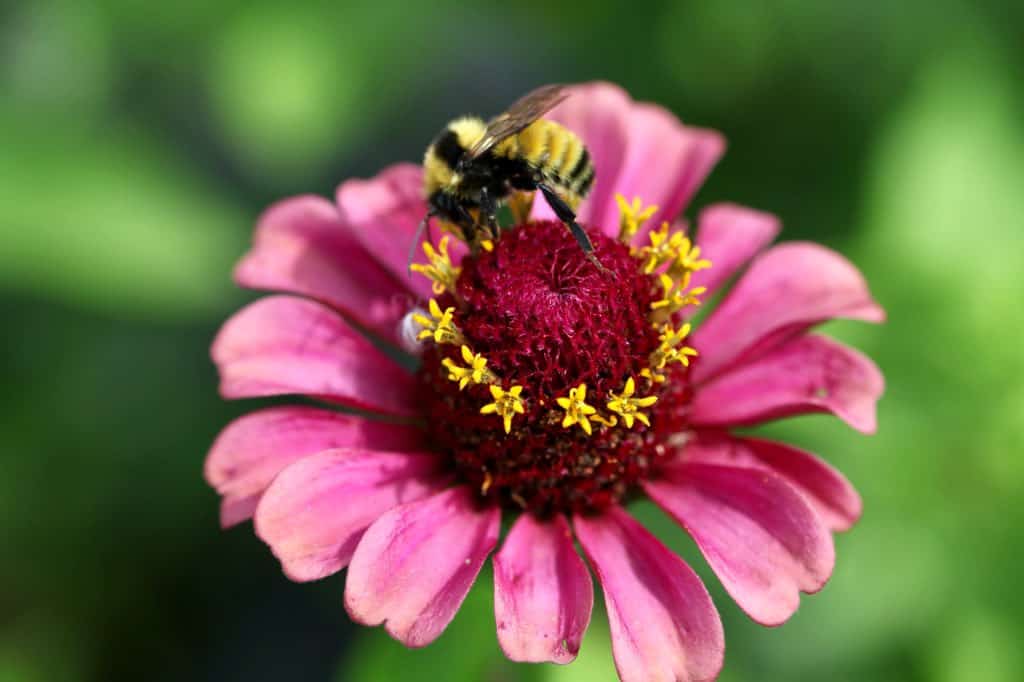
6. Post Flowering Stage
The post flowering stage occurs on each zinnia bloom when the flower becomes spent.
This stage is one in which the spent flowers begin to produce seeds, if they have been pollinated, and are left on the plant.
There may be a reduction in blooming if the zinnia plant has a lot of spent blooms, and is putting lots of energy into the seed making process.
In order to stimulate the plant to make more blooms, you can deadhead the spent blooms. This will divert the energy from seed making, back into the plant for more bloom production.

7. Seed Production
The last zinnia growth stage is one of seed production.
Zinnia seeds are produced after the flower has been pollinated. The seeds will form at the base of the ray petals, as well as within the central disc of the flower.
In order for the zinnia seeds to be viable, the spent blooms should remain on the zinnia plant until they become brown and dry.

The seeds produced by these hybrid zinnias will be hybrids themselves, and not exactly the same as the original plant or the parent plant.
Zinnia seeds are often arrowhead shaped, especially those found on the ends of the ray petals. Others may be oblong, and sometimes those seeds found inside the central disc are long, dark and firm.
Although the seeds found in these different locations may look different, they are all zinnia seeds.
If allowed to mature on the plant, zinnia seeds can be saved to be planted out again, for the following seasons to come.
Generally you will find many seeds in just a few spent blooms. You will likely find not only enough seeds for yourself, but also enough to share with a few gardening friends who also love zinnias.
Store the seeds in a cool dry place for best storage practice.

Factors Affecting Zinnia Growth Stages
There are a number of factors which can affect the zinnia growth stages.
These include soil temperature, moisture provision, soil quality and drainage, planting location, and pests and diseases.
Common Problems That Can Occur During Zinnia Growth Stages
Soil Temperature
- Zinnias are warm weather plants, and warm soil will help with the germination process.
- If the zinnia seeds have been planted into cool soil, they will likely take longer to germinate and grow.
- If planted indoors, place the container on a heat mat to help warm the soil.
- For direct sown seeds outdoors, make sure to plant when the weather and soil has warmed up for best germination. Also make sure to plant after the threat of frost has passed.

Moisture Provision
- Always make sure to keep the soil moist while the zinnia seeds are germinating. If the soil is left to dry out, the seeds can become damaged, and the plants may not survive.
- When the zinnias are planted in their final location they will tolerate some dry conditions, however they will also respond well to soil moisture and watering, showing growth of the plants.
- Make sure that the planting area has good drainage, because zinnias do not like wet feet.
- Although the zinnia plants are drought tolerant, when they are too dry, the plants tend to wilt. The wilting is a sign of stress, and the plants should be watered immediately, if they are found to be wilting.
- Stressed plants can interfere with optimal growth.
Soil Quality
- Poor soil quality can interfere with the zinnia growth stages by interfering with growth.
- The plants tend to be larger with taller flowering stems if grown in soil which is rich and fertile, and full of organic matter.
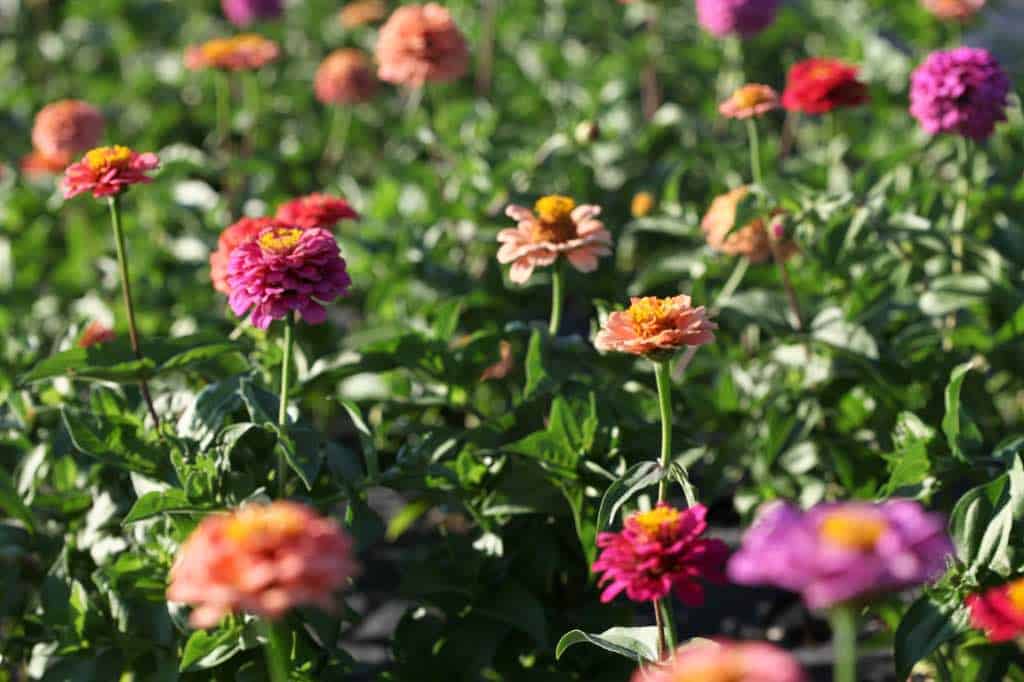
Planting Location
- These heat loving and sun loving plants will always do best and show their best growth if planted in full sun, rather than in a shady location.
- If zinnias are planted in a shade or partial shade location, there will be less optimal growth and less flowering potential, than if planted in a full sun location.
- The zinnia plants require at a minimum 6 hours of sunlight every day, however will benefit from a full day of direct sun exposure if possible.
Pests And Diseases
- Snails, slugs, and sometimes spider mites tend to love the tender foliage of young zinnia plants. They will eat the leaves, with the snails and slugs leaving large holes.
- Spider mites will cause discoloration to the leaf surface, and can damage the plants.
- This damage can lead to stress of the plant and interfere with it’s growth. Remove the larger pests by hand picking, and treat smaller pests organically if possible, with insecticidal soap.
- Powdery mildew is a common fungal disease in zinnia plants. It can occur in moist locations, and with overcrowding of plants.
- Try to space the zinnias so that they are not overcrowded, and therefore will have good air circulation and air flow between plants. This can help to prevent the development of powdery mildew.
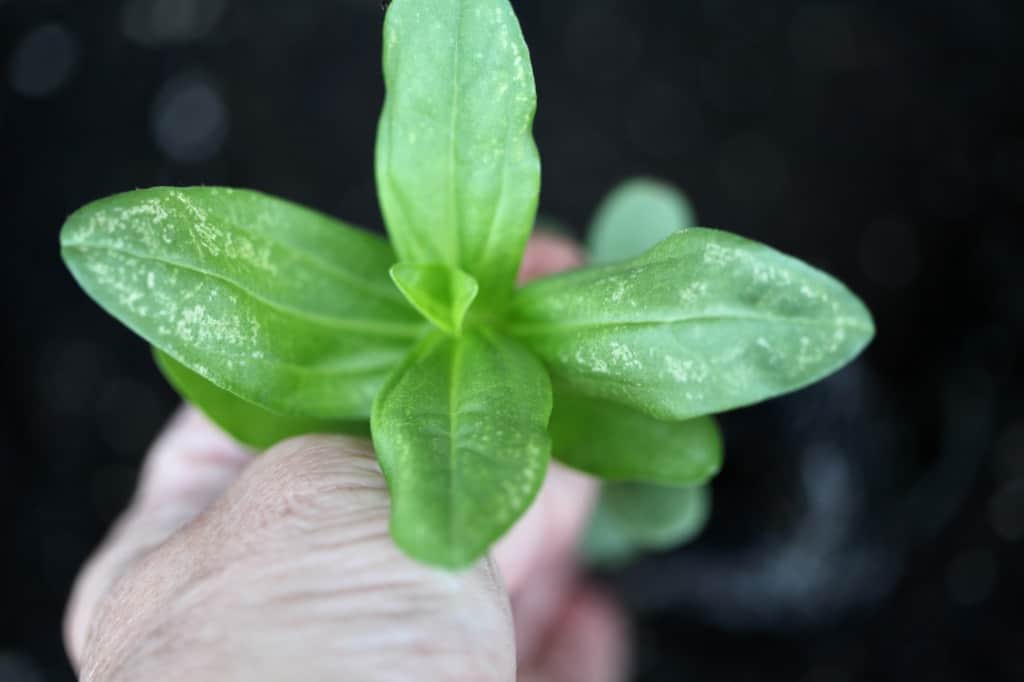
Frequently Asked Questions
How Long Do Zinnias Typically Bloom For?
Once the zinnia plants begin to bloom, they will continue to produce flowers all season long, right up until the first frost of late fall.
Each mature zinnia stem can bloom for several weeks before becoming spent.
There are always different stages of zinnia blooms present on each plant, so there are usually flowers blooming on every plant all season long.
Once the first frosts arrive however, this will usually cause damage to the flowers. Zinnias are very tender to cold temperatures and frosts, and you will see evidence of the frost damage on the flower petals.
At this point in time I stop harvesting the blooms. I then wait for the flowers to turn brown and dry, and then harvest and collect the seeds for next year’s plantings.

Can Zinnias Be Grown Indoors?
Zinnias can be started from seeds indoors, and grown indoors under lights in the seedling stage.
The plants may even flower, and produce tiny little blooms on the seedlings under the lights while awaiting planting out.
However, the zinnias are best transplanted outside, where they can be exposed to a full sun location. Outside the plants can spread their roots and grow under the direct sunlight.
This is much better for the plants rather than being grown indoors for the growing season.
The zinnia plants do however grow very well in containers.
If you have an area adjacent to your home such as a deck or patio, the containers can be filled with these colorful plants to enjoy closer to your living space.

How To Properly Harvest Zinnias During The Flowering Stage
During the flowering stage, zinnias can be harvested from on a regular basis. As each stem is cut from the plant, another is likely to grow and replace with another blooming stem.
Make sure that the flower you are cutting is mature by doing the wiggle test prior to cutting.
Sometimes the blooms have the appearance that they are mature and ready to be cut, however they are not. These immature blooms can easily break and snap off from the stem.

After doing the wiggle test, and determining that the flower is mature, it’s time to make the cut.
Follow the stem from the bloom, reaching deep down into the plant. Go as low as you can go, right down to the main stem at the base of the plant.
Remove the stem which you plan to cut, adjacent to the main stem. Make a clean cut with a pair of sharp clippers.
You will likely have some side branches as well on the cut stem, which can be removed.
Remove the foliage and branches from the stem. I generally leave about 2 to 4 leaves on the top of the stem along with the flower.
Place the stem immediately into water, and allow the stem to condition for several hours in a shady location before using.

Conclusion
Zinnias are some of the easiest annual flowers to grow in the garden during the summer months. These plants can be grown in warmer climates as well as in cooler climates, in the warmest part of the growing season.
Knowing the zinnia growth stages helps us to know how the zinnia plant grows, and what to expect along the way for this adaptable plant.
There are certain techniques that we can use during the different stages to provide good care to the plant.
Proper zinnia care will help us to grow the most magnificent zinnia blooms that we can.
These easy to care for plants are fun and easy to grow. I hope that you will be able to grow some zinnia plants in your garden this season, to bring lots of joy and wonder to everyone who sees them.

Other Posts You May Like:
See the Web Story on Understanding the Zinnia Growth Stages!
PIN IT FOR LATER!
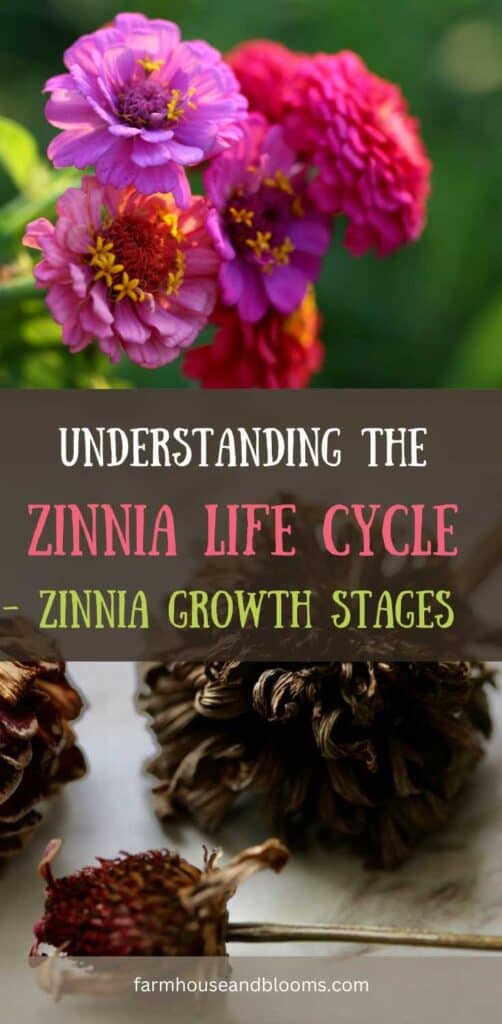




Leave a Reply